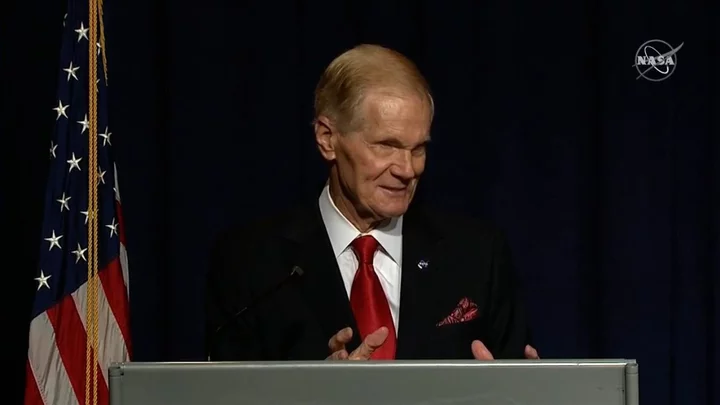
DirecTV and Nexstar Reach Multi-Year Distribution Agreement
Nexstar Media Group Inc. and satellite-TV provider DirecTV have reached a new multi-year distribution agreement covering 176 of
2023-09-18 21:51

UK focuses on transparency and access with new AI principles
By Paul Sandle LONDON (Reuters) -Britain set out principles designed to prevent generative AI models like ChatGPT from being dominated
2023-09-18 19:15

Your Smartwatch Is Absolutely Filthy With Germs, According to Science
There's no easy way to say it, but your Fitbit might have a little poop on it.
2023-09-17 22:18

Billionaire Case Bets on Superfast Jet, AI Beyond Silicon Valley
Steve Case is excited about speed. Specifically, a Mach 5 aircraft that will be capable of getting from
2023-09-16 21:26

What is Mercury in retrograde and why do so many people believe it impacts their lives?
Having a bad day? Mercury in retrograde. Broken your phone this morning? Mercury in retrograde. Had a sudden and unexpected breakup? Mercury in retrograde. It only takes a quick swipe through social media to see this cosmic event taking the blame for pretty much everything – and according to the age-old astrological theory, we are all influenced by its effects. Astrologers have been examining Mercury retrograde for thousands of years, but it wasn't until 2010 when Google searches started to spike. Now, with the help of Instagram and the drive towards self-care and mindfulness, interest in astrology has heightened to a whole new level. While Mercury retrograde is far too often viewed as a negative thing, it is also said to be the perfect time for self-reflection and growth. Laura Hayes, certified astrologer and founder of the online astrology community, @astrohuns, spoke with Indy100 to break down this astrological phenomenon. Sign up to our free Indy100 weekly newsletter What does Mercury retrograde mean? To put it simply, Mercury retrograde occurs when the planet Mercury – which takes 88 days to orbit the Sun, as opposed to Earth's 365 – appears to go backwards in its orbit. In Astrology, Mercury – named after the Roman deity who served as a messenger to the gods – is the planet of communication and the mind. Hayes explained: "Its placement in your birth chart affects how you think and communicate. Additionally, Mercury's transits at any given time will also have an impact on our thoughts and way of communicating." How long does it last? It tends to last around three to four weeks a time. However, there is also a "shadow period" – or retroshade – before and after Mercury Retrograde. This can apparently make things "a little rocky." "This Retroshade period lasts about 2-3 weeks and is almost like a diluted form of the retrograde itself," Hayes said. "Therefore, you may begin to feel the effects of Mercury retrograde a few weeks before it begins and still feel its lingering effects for a few weeks afterwards." How can it 'impact your life'? Astrologically speaking, when Mercury is in retrograde, the areas of life associated with the planet are said to be affected. "You are said to have verbal communication difficulties at this time, causing you to mishear someone or say the wrong thing, leading to arguments and misunderstandings," Hayes explained. People can find themselves "stumbling over their words, saying the wrong thing, or struggling to think coherently altogether." "Phones can lose signal; steamy texts to bae get sent to your boss instead, or your laptop breaks down when you're in the middle of writing your memoirs," she added. "Travel is another area that gets messed up during Mercury Retrograde, so be careful on the road and make sure to double-check flight details before you book." What can people do to deal with said 'effects'? According to KJ Atlas, consulting astrologer, writer, and artist of the human aura, you shouldn't put your life on hold purely because Mercury is retrograde. Instead, she says it is a time to significantly slow down. "You're more likely to make mistakes during this period, but if you listen to the call to take it easy, spend more time in self-care, go out less, and prioritize your mental and physical health, you'll be just fine," she explained. "If you need to sign contracts, purchase something significant, or have a deep talk, just do so mindfully and do your due diligence." Atlas acknowledged one positive rule of thumb: People are encouraged to do anything with the prefix 're'. "If you’re in a situation that you don’t enjoy, you can use this period for reevaluation or rekindling, but wait to take action until the cycle has ended. This includes the pre and post shadow periods. "People often jump right back into things that might be warnings during Mercury retrograde on the day that it’s technically over, but it’s good practice to wait a few days." When does Mercury retrograde occur? Mercury retrograde occurs three to four times per year. It tends to occur roughly around the same time each year. The dates* for this year are: January 14th - February 4th May 10th - June 3rd September 10th - October 2nd December 29th - January 18th (2023) *dates based on GMT, so they may vary slightly in other time zones. It's worth noting that astrology is not the same thing as astronomy. Astrology is a belief system that the stars and planets allow us to 'read a person', predict the future or have the ability to alter our daily lives, as above. Astrology can be important to some cultures, but it is not based on scientific evidence. Astronomy, however, is backed by data. David J. Helfand, Professor of Astronomy and Columbia University Chair, slammed the astrological theory as "arrant nonsense." Helfand explained that the retrograde motion of Mercury is a "simple consequence of the fact that we observe the sky from a moving platform we call Earth as it orbits the Sun. The other planets also orbit the Sun, all in the same direction." "The apparent motion of any planet as observed from Earth is a combination of the orbit of the planet and the orbit of Earth," he added. "Simple geometry shows that roughly three times a year (for Mercury – less often for other planets on longer orbits), these combined motions give the Earth-bound observer the illusion that the other planet has reversed its direction of motion compared to the background stars." He stated that the orbit of Mercury is governed by laws of gravity and is completely unchanged, which has "been well-understood for over 400 years – it's hardly a new idea." "But apparently, some people prefer 2000-year-old views of the world in which the planets govern their lives – no need to take any personal responsibility then, is there?" "In fact, the gravitational force of Mercury on an Earth-bound you is less than the force of your dog on you when you pat him or her on the head," Helfand explained. "Indeed, patting your dog on its head is likely to have a positive influence on your mood. Maybe people should try that instead of contemplating arrant nonsense about the planets." Have your say in our news democracy. Click the upvote icon at the top of the page to help raise this article through the indy100 rankings.
2023-09-15 19:50

Video of GoFast UFO resurfaces after being mentioned in NASA report
NASA lifted the lid on its unidentified anomalous phenomena study on Thursday (14 September) which aimed to identify "how data gathered by civilian government entities, commercial data, and data from other sources can potentially be analysed to shed light on UAPs." While the report was "not a review or assessment of previous unidentifiable observations," the briefing prompted a video of 'GoFast UFO' to resurface. The clip from 2014 was released by the pilots "to clear up any misconceptions by the public on whether or not the footage that has been circulating was real or whether or not there is more to the videos." The statement on the Department of Defense further went on to say at the time: "After a thorough review, the department has determined that the authorized release of these unclassified videos does not reveal any sensitive capabilities or systems, and does not impinge on any subsequent investigations of military air space incursions by unidentified aerial phenomena." The clip also got a mention in the recent 36-page report, published on the NASA website. "A well-known UAP event is the “GoFast” video, recorded by navy aviators from the USS Theodore Roosevelt," it read. @uapbrand GOFAST UAP - better known as the 'Tic Tac' UFO. 🛸 #UAP #UnidentifiedAerialPhenomena #UAPs #OVNI #OVNIs #UFO #UFOs #UFOvideo #UFOvideos "A still frame from this video is shown in the Figure below, where the infrared camera has locked onto a small object in the center. The video gives an impression of an object skimming above the ocean at a great velocity. But analysis of the numerical information on the display reveals a less extraordinary interpretation." Elsewhere, while the report disclaimed the galaxy "does not stop at the outskirts of the solar system," it stressed there is "no reason to conclude" that UFO sightings are alien. "Many of NASA's science missions are, at least in part, focused on answering the question of whether life exists beyond Earth," it read. "Those investigations include missions looking for biosignatures, perhaps on Mars or the icy moons orbiting Jupiter and Saturn - as well as farther afield, in the ratios of molecules present in exoplanet atmospheres. "Searching for signs of alien technology is a natural extension of those investigations." It added: "If we recognise the plausibility of any of these, then we should recognise that all are at least plausible." Sign up for our free Indy100 weekly newsletter Have your say in our news democracy. Click the upvote icon at the top of the page to help raise this article through the indy100 rankings.
2023-09-15 16:52

Extreme Weather Is Forcing Redesign of World’s Busiest Airports
Airports around the world are relocating sensitive electrical equipment to rooftops to protect it from flooding, reinforcing runways
2023-09-15 13:29

South Korean AI chip intellectual property startup valued at $81.4 million
By Max A. Cherney (Reuters) -The South Korean chip startup Panmnesia has raised a seed round that values it at
2023-09-15 10:51

Methane from Oil and Gas Are Worse Than Reported to UN, Satellites Show
Observed methane releases from global oil and gas operations are 30% higher than what countries estimate in reports
2023-09-15 07:20

5 things we learned from Nasa's report on UFOs
NASA has released details from its unidentified anomalous phenomena (a term to describe UFOs that can't be identified) study. When the study started a year ago, NASA set out to identify "how data gathered by civilian government entities, commercial data, and data from other sources can potentially be analysed to shed light on UAPs." They went on to highlight that Thursday's report (14 September) "is not a review or assessment of previous unidentifiable observations." Here are five major things we learned from the 36-page report: NASA should be more proactive when it comes to UFOs The report suggests that the space agency should use better techniques and vices when searching for UAPs. They said the current UAP detection is "often serendipitous," and captured by sensors "that were not designed or calibrated for this purpose, and which lack comprehensive metadata." This means the origin of several UAPs "remain uncertain". "The importance of detecting UAP with multiple, well-calibrated sensors is thus paramount, and accordingly we recommend that Nasa leverage its considerable expertise in this domain to potentially utilize multispectral or hyperspectral data as part of a rigorous data acquisition campaign," they wrote. Many 'credible witnesses' have reported UFOs The report revealed that many "credible" reports of "objects they did not recognise over US airspace" have come through from witnesses, "often military aviators". "Most of these events have since been explained, but a small handful cannot be immediately identified as known human-made or natural phenomena," it read. It noted that one of the problems when it comes to such sightings is that "the data needed to explain these anomalous sightings often do not exist." They added: "This includes eyewitness reports, which on their own can be interesting and compelling, but are not reproducible and usually lack the information needed to make any definitive conclusions." 'No reason to conclude' UFOs are alien While the report disclaimed the galaxy "does not stop at the outskirts of the solar system," it stressed there is "no reason to conclude" that UFO sightings are alien. "Many of NASA's science missions are, at least in part, focused on answering the question of whether life exists beyond Earth," it read. "Those investigations include missions looking for biosignatures, perhaps on Mars or the icy moons orbiting Jupiter and Saturn - as well as farther afield, in the ratios of molecules present in exoplanet atmospheres. "Searching for signs of alien technology is a natural extension of those investigations." It adds: "If we recognise the plausibility of any of these, then we should recognise that all are at least plausible." Satellites could potentially be used in the search for aliens "NASA is in an excellent position to contribute to UAP studies within the broader whole-of-government framework," they wrote, going on to explore the potential role of the "US commercial remote-sensing industry" which they say "offers a potent mix of Earth-observing satellites that offer imagery at sub- to several-meter spatial resolution, which is well-matched to the typical spatial scales of known UAP [UFOs]". They continued: "Such commercial constellations could offer a powerful complement to the detection and study of UAP when coincident collection occurs." Artificial intelligence could also help the hunt for aliens "The panel finds that artificial intelligence (AI) and machine learning (ML) are essential tools for identifying rare occurrences, potentially including UAP, within vast datasets," they wrote. "However, these powerful techniques will only work on well-characterized data gathered with respect to strong standards." They went on to note that the public "is also a critical aspect of understanding UAP". There's a lot more to learn "The top takeaway from the study is that there is a lot more to learn," NASA Administrator Bill Nelson said while releasing the report. "The NASA independent study team did not find any evidence that UAP have an extraterrestrial origin, but we don't know what these UAP are." Sign up for our free Indy100 weekly newsletter Have your say in our news democracy. Click the upvote icon at the top of the page to help raise this article through the indy100 rankings.
2023-09-15 00:15

Nasa says mysterious ‘UFO’ sightings cannot yet be explained
Nasa cannot yet explain all of the mysterious sightings that have been spotted in the sky, a major new report has said. A panel assembled by the space agency to examine Unidentified Anomalous Phenomena, or UAPs, said that more and better data is required to be able to explain them. :: Follow our live blog on the Nasa report here. Recently, a number of people – primarily military pilots – have said they have spotted unrecognisable objects over the US. While some have been explained as having known natural or human-made causes, some continue to defy explanation. To better understand where those still mysterious phenomena are coming from, the space agency’s panel urged it to come up with “a rigorous, evidence-based, data-driven scientific framework” to better examine and understand them. Some of that can be done by Nasa, it said, and the space agency should play a “prominent role”. But the research must be done across the US government. Nicola Fox, the associate administrator of Nasa’s Science Mission Directorate, says begins the report by saying that UAPs are “one of our planet’s greatest mysteries”. “Observations of objects in our skies that cannot be identified as balloons, aircraft, or natural known phenomena have been spotted worldwide, yet there are limited high-quality observations,” she writes. “The nature of science is to explore the unknown, and data is the language scientists use to discover our universe’s secrets. “Despite numerous accounts and visuals, the absence of consistent, detailed, and curated observations means we do not presently have the body of data needed to make definitive, scientific conclusions about UAP.” Read More Nasa’s UFO study team reveals first ever report: Live updates Information Commissioner urges people to share data to protect at-risk children iPhone 12 is not emitting dangerous radiation, Apple says, amid fears of Europe ban
2023-09-14 21:50

iPhone 12 is not emitting dangerous radiation, Apple says, amid fears of Europe ban
Apple has denied claims that its iPhone 12 emits illegal levels of radiation for users, amid fears that the phone could face a Europe-wide recall. France’s National Frequency Agency (ANFR) said on Tuesday that tests had revealed unusually high levels of electromagnetic radiation being emitted from the device. The smartphone, which was released in 2020, has a reported Specific Absorption Rate (SAR) that is 40 per cent above the legal limit, according to to agency. The ANFR therefore ordered Apple to halt sales of the device and warned that a recall would follow if Apple fails to fix the problem. A spokesperson for Apple told The Independent that it contests the results of the findings made by the AFNR and is engaging with the regulator in an effort to prove that its iPhone 12 is compliant. The US tech giant said it has provided the ANFR with independent third-party lab results proving the iPhone 12’s compliance, and has already been certified by multiple international bodies that it meets SAR regulations. The Independent has reached out to the AFNR for comment. Other regulators across Europe have warned that the French findings could have implications for the rest of the continent, with Belgium, Germany and the Netherlands all signalling that they might follow the sales ban. Dutch digital watchdog Rijksinspectie Digitale Infrastructuur (RDI) said on Wednesday that there did not appear to be an “acute safety risk” but that the Netherlands attached “as much importance as France to safe use of mobile phones”. On Tuesday, France’s junior minister for digital economy said that the ANFR’s findings would be shared with other EU member states, warning that it could have a “snowball effect” for the smartphone maker. Apple is set to discontinue sales of the iPhone 12 following the launch of the iPhone 15 earlier this week, however any potential recall could prove damaging. German regulators said on Thursday that the French procedure could have implications for the whole of Europe. Read More France’s iPhone 12 ban could spread across Europe, regulators say
2023-09-14 20:55
